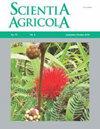Assessment of grape volatile composition using fluorescence indices of leaves in vineyards affected by iron chlorosis
IF 2.6
3区 农林科学
Q1 Agricultural and Biological Sciences
引用次数: 0
Abstract
: Multiplex 330 (MX) is a portable, non-invasive fluorescence sensor that provides different multiparametric indices that are sensitive to the concentration of chlorophylls, flavonols, and anthocyanins on the leaf surface. This study investigated the use of these indices to assess the variability on free volatile composition of grapes ( Vitis vinifera L.) in the field as well as other components of their quality potential in vineyards affected by iron deficiency chlorosis (IDC). Twenty non-irrigated Tempranillo/110 Richter vineyard subzones from non-affected to moderately affected by IDC were monitored in Ribera del Duero area (Spain) during two seasons. The results indicated that MX can characterize the spatial variation of leaf pigment concentrations, agronomic performance, and grape quality in vineyards affected by IDC. The MX indices measured at the leaf level close to harvest had better predictive values for the concentrations of free alcohols, volatile acids, C13-norisoprenoids, esters and acetates in the must than vine vigor, size or degree of technological maturity of the grapes. Our study demonstrates that the MX indices to estimate leaf pigment concentrations can be helpful to assess the technological maturity and free volatile composition of wine grapes in vineyards affected by IDC; nevertheless, the efficacy of the indexes may vary according to the year season.利用铁萎黄病葡萄园叶片荧光指数评价葡萄挥发性成分
本文章由计算机程序翻译,如有差异,请以英文原文为准。
求助全文
约1分钟内获得全文
求助全文
来源期刊

Scientia Agricola
农林科学-农业综合
CiteScore
5.10
自引率
3.80%
发文量
78
审稿时长
18-36 weeks
期刊介绍:
Scientia Agricola is a journal of the University of São Paulo edited at the Luiz de Queiroz campus in Piracicaba, a city in São Paulo state, southeastern Brazil. Scientia Agricola publishes original articles which contribute to the advancement of the agricultural, environmental and biological sciences.
 求助内容:
求助内容: 应助结果提醒方式:
应助结果提醒方式:


